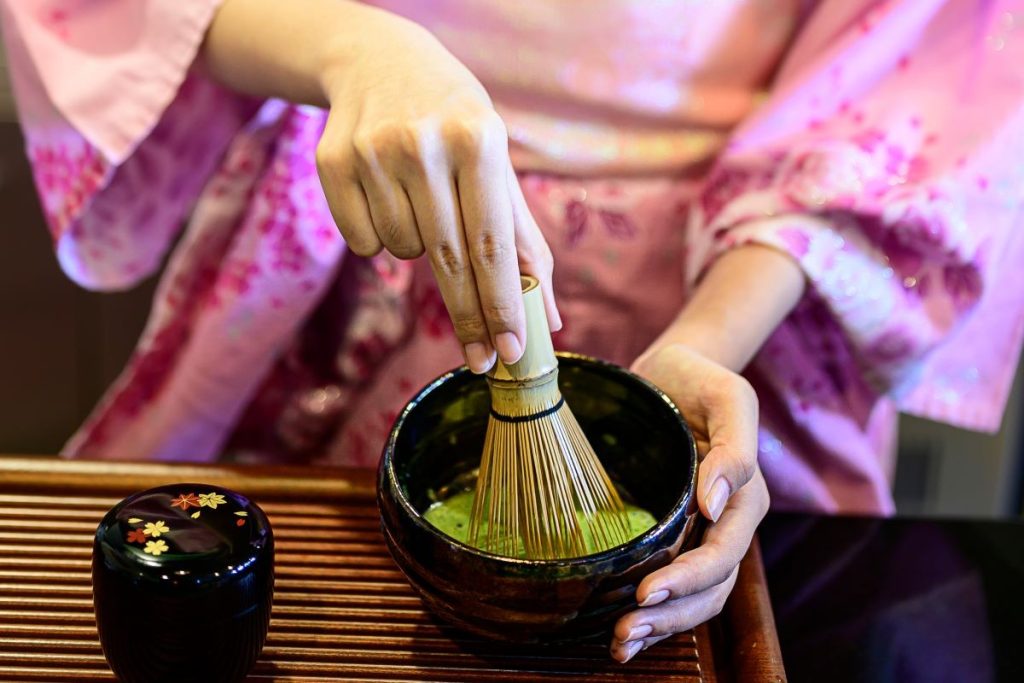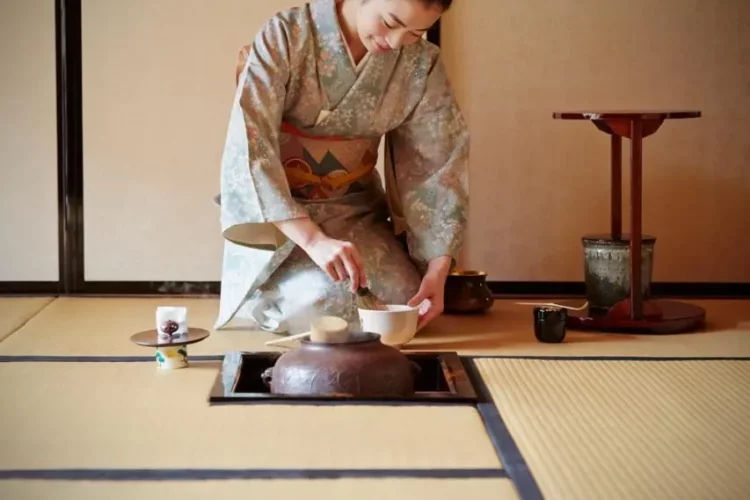The Japanese tea ceremony, or “chanoyu”, is far more than just the preparation and drinking of tea. It is a profound cultural practice that represents deep philosophical and spiritual beliefs that have evolved over centuries. The tea ceremony is a unique experience where simplicity, nature, and mindfulness come together to create an atmosphere of peace and reflection. For those who partake in it, the ceremony offers more than a cup of tea—it’s a journey into the heart of Japanese culture.
1. A Tradition Rooted in History
The Japanese tea ceremony can trace its origins back to the 9th century, though it wasn’t until the 15th and 16th centuries that it began to take the form we recognize today. Initially, tea drinking in Japan was a practice reserved for Buddhist monks, who used powdered tea for its calming and meditative properties. As time progressed, tea culture spread to the Japanese aristocracy, where it became a symbol of elegance and refinement.
However, it was during the Muromachi period (1336–1573) that the tea ceremony began to be shaped into its current form, largely thanks to influential figures like Sen no Rikyū. Rikyū, a tea master in the 16th century, is credited with creating the principles of the tea ceremony that are still followed today. He emphasized simplicity, humility, and the appreciation of the transient beauty found in nature. His teachings influenced the development of the ceremony into a practice that blends art, philosophy, and mindfulness.
2. The Spiritual Core: Wabi-Sabi and the Beauty of Imperfection
At the heart of the tea ceremony lies the concept of “wabi-sabi”, a Japanese aesthetic that celebrates imperfection, transience, and the beauty found in the simplest of things. The practice of the tea ceremony reflects this philosophy, as everything in the ceremony is chosen and executed with an appreciation for naturalness and impermanence.
In a tea room, the utensils, the setting, and even the way tea is served are chosen with great care. The tea bowl, for instance, may have slight imperfections, such as cracks or irregular shapes, which are not seen as flaws but as part of its unique beauty. These imperfections speak to the concept of wabi-sabi, where the aging of an object or the passage of time adds to its character and value.
Moreover, the tea ceremony takes place in a setting designed to bring nature indoors. The utensils and decorations, including the flowers displayed in the tokonoma (alcove), and the seasonal selection of tea, all reflect the fleeting nature of life and the beauty of the present moment. The idea of “mono no aware”, which translates to “the pathos of things,” encourages participants to appreciate the impermanence of life, seeing beauty in moments that are fleeting and transient.
3. A Ritual of Mindfulness: The Pursuit of Harmony and Respect
One of the key aspects of the tea ceremony is its deeply meditative nature. Every action, no matter how small, is performed with meticulous care and attention. Whether it’s the precise way the tea is whisked or the careful placing of the utensils, the ceremony is a practice of mindfulness. In a world filled with distractions, the tea ceremony offers a space to be fully present in the moment, focusing on the task at hand and cultivating inner calm.
The ceremony is also guided by four central principles that form the foundation of its practice. These principles are:
- Wa (和): Harmony – This refers to the harmonious relationship between the participants, the utensils, and the environment. There is an emphasis on creating an atmosphere of mutual respect and peace.
- Kei (敬): Respect – The tea ceremony fosters an environment of respect for oneself, others, and the objects involved. Each action is done with reverence.
- Sei (清): Purity – Purity refers not only to the cleanliness of the utensils and the environment but also to the mind and spirit of the participants. It is about cleansing oneself of distractions and being present.
- Jaku (寂): Tranquility – The ultimate goal of the tea ceremony is tranquility. Through the careful preparation and appreciation of tea, participants experience a deep sense of peace and calm.
In essence, the tea ceremony teaches participants to live in the present, practice patience, and find beauty in the simple things. It is a way of experiencing the world with greater clarity and a deeper sense of connection.
4. The Aesthetic and Symbolism of the Tea Room
The tea room itself plays a crucial role in the ceremony. Designed to be humble and unadorned, it is often small, with simple wooden floors, tatami mats, and a few carefully selected items for decoration. The space is intentionally minimalistic, designed to encourage participants to focus on the present and disconnect from the external world.
Every element in the tea room is symbolic. The chaji (main tea ceremony) can last for several hours and involves a series of rituals that bring participants through a spiritual journey. During this time, participants leave the hustle and bustle of the outside world behind and step into a space of stillness, guided by the tea master.
One significant feature of the tea room is the tokonoma, an alcove in which seasonal decorations, such as flowers or calligraphy, are displayed. The objects in the tokonoma reflect the changing seasons, reinforcing the theme of impermanence. Each display is carefully selected to evoke a particular mood or feeling that complements the tea ceremony’s atmosphere.

5. The Role of the Tea Master: A Guardian of Tradition
The tea master holds a crucial role in the ceremony, serving not only as the one who prepares the tea but also as the custodian of tradition. Becoming a tea master involves years of training and dedication, as they must learn not only the technical aspects of the tea ceremony but also the deeper philosophical and spiritual principles behind it.
The tea master’s role is to guide the participants through the ceremony, ensuring that each action is performed with grace, respect, and mindfulness. Through their precise movements, the tea master teaches the importance of attention to detail, humility, and the beauty of simplicity. The ability to make tea with skill and grace is seen as a reflection of one’s inner character and spiritual development.
6. The Tea Ceremony as a Means of Connecting with Others
While the Japanese tea ceremony is often a personal and intimate experience, it also serves as a means of connecting with others. Whether it is a formal gathering or a more casual tea ceremony, the act of sharing tea with others fosters a sense of unity and harmony. Participants in the ceremony are reminded of the importance of respect, both for themselves and for those around them.
The practice of serving tea is an act of generosity. The tea master prepares each cup with care, considering the preferences of each participant and creating an experience tailored to their needs. Likewise, guests are expected to show appreciation for the tea and the hospitality offered. This reciprocal act of giving and receiving creates a sense of mutual respect and deepens the connection between people.
The tea ceremony also highlights the importance of community. Whether in the family, the workplace, or with friends, the shared experience of tea drinking helps to strengthen social bonds. In Japanese culture, the ceremony can be seen as a way of fostering relationships, creating shared moments of peace and harmony amidst the busyness of daily life.
7. The Global Impact: Japanese Tea Ceremony Beyond Japan
Though the tea ceremony is rooted in Japanese culture, its influence has spread worldwide. In recent decades, the practice has become an art form appreciated by people of many cultures, transcending the boundaries of Japan. Tea ceremony schools have opened in various countries, and people from around the world participate in workshops to learn about the cultural, spiritual, and philosophical significance of the ceremony.
The principles of the tea ceremony—mindfulness, simplicity, and respect—have found resonance in various aspects of global culture, particularly in practices like mindfulness meditation and minimalism. The tea ceremony offers a universal message: by embracing the present moment, appreciating the simplicity of life, and fostering genuine human connection, we can achieve a sense of peace and fulfillment.
Conclusion: More Than Just Tea – A Lesson in Life
The Japanese tea ceremony is much more than a simple ritual of preparing and drinking tea. It is a practice that encompasses philosophy, aesthetics, and spirituality, teaching participants to appreciate the fleeting beauty of life, embrace imperfection, and connect deeply with the present moment. Rooted in the principles of wabi-sabi and guided by the concepts of harmony, respect, purity, and tranquility, the tea ceremony offers a unique lens through which we can explore and reflect on our own lives.
In a world that often rushes by, the Japanese tea ceremony reminds us to slow down, appreciate simplicity, and find peace in the ordinary moments. It is a celebration of life, nature, and human connection—a cultural treasure that continues to inspire and teach, long beyond the walls of a tea room.





















